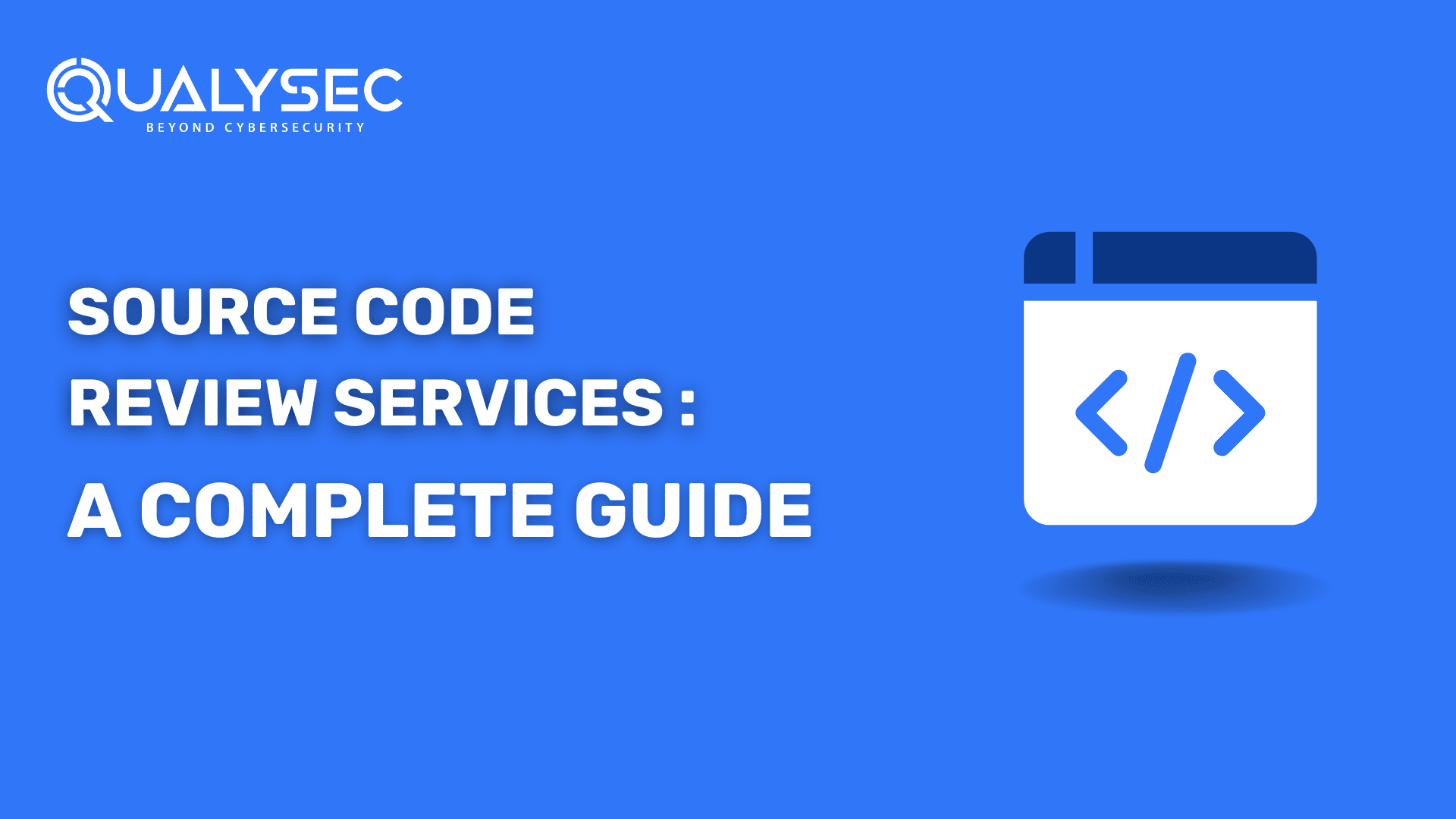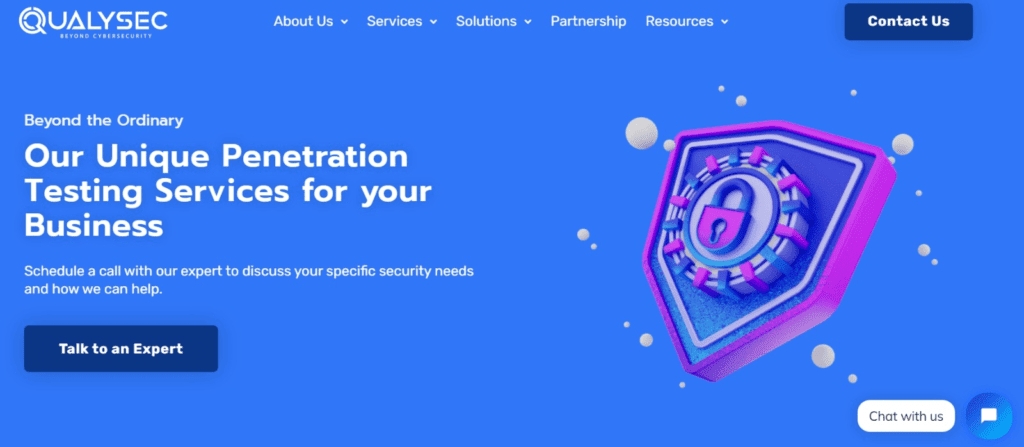© 2024 Qualysec.com Disclaimer Privacy Policy Terms & Conditions

In the dynamic world of software development, the concept of security has taken center stage. As technology advances and software applications become increasingly integral to our daily lives, ensuring the security of these applications has never been more important. The ubiquity of cyber threats, ranging from data breaches to ransomware attacks, underscores the critical need for robust code security measures with source code review services.
Code security, also known as application security, refers to the practice of safeguarding software applications from potential threats and vulnerabilities that could be exploited by malicious actors. These vulnerabilities can arise due to coding errors, design flaws, or inadequate security practices during the development process. The consequences of overlooking code security can be severe, encompassing financial losses, compromised user data, damage to reputation, and legal ramifications.
In the pursuit of airtight code security, source code review services emerge as a fundamental strategy. These services involve a meticulous examination of the source code that constitutes the foundation of a software application. Unlike automated security testing tools that primarily target surface-level vulnerabilities, source code review services delve deep into the intricate lines of code, unraveling potential weaknesses that might not be easily detectable through automated scans.
Source code review services play a pivotal role in identifying security vulnerabilities within the codebase. These vulnerabilities might include flaws in authentication mechanisms, data validation processes, or insufficient encryption practices. Expert reviewers meticulously analyze the logic, architecture, and flow of the code to uncover these vulnerabilities.
Once identified, these vulnerabilities are not just highlighted but also contextualized. Source code review experts provide insights into the potential impact of these vulnerabilities and offer recommendations for remediation. This tailored approach allows developers to understand the specific security risks posed by certain lines of code and empowers them to make informed decisions about how to address them.
Moreover, source code review services extend beyond the identification of vulnerabilities. They also contribute to a proactive security culture by offering best practices, coding guidelines, and insights into security-conscious coding practices. This educational aspect of source code review services equips development teams with the knowledge needed to integrate security into their coding practices from the outset.
Source code review services are a comprehensive and systematic examination of the source code that constitutes a software application. These services are designed to identify security vulnerabilities, code quality issues, and compliance concerns within the codebase. In essence, source code review services act as a critical checkpoint in the software development lifecycle, ensuring that the code is not only functional but also secure and robust.
Source code review services are typically integrated into the development process at various stages, with the goal of identifying vulnerabilities and issues before they escalate. They can be conducted during the design and coding phase, as well as during code review sessions before deployment. Integrating these reviews early in the development cycle helps in addressing potential issues when they are less complex and costly to fix.
There are two primary approaches to conducting source code reviews: manual and automated. Each approach has its own set of advantages and limitations, making them suitable for different scenarios.
Manual source code review involves human security experts carefully analyzing the source code line by line to identify vulnerabilities and issues. This approach offers several benefits:
Automated source code review relies on specialized tools and software to scan the source code for known patterns of vulnerabilities and issues. While not as contextually adept as human reviewers, automated approaches offer their own advantages:
In many cases, a hybrid approach that combines both manual and automated source code review techniques yields the best results. This approach leverages the speed and efficiency of automated tools to identify common vulnerabilities, while also harnessing the expertise of human reviewers to uncover more intricate issues.
In an increasingly interconnected world, the significance of code security cannot be overstated. Ignoring code security issues can lead to a cascade of detrimental consequences that can impact businesses, users, and even entire industries. Let’s delve into the potential repercussions of neglecting code security and examine real-world examples that underscore the importance of rigorous source code review.
Source code review services play a pivotal role in detecting a wide range of common security vulnerabilities that can compromise the integrity and security of software applications. Let’s explore some of these vulnerabilities and provide illustrative code snippets to better understand their nature.
Description: SQL injection occurs when an attacker manipulates input data to execute malicious SQL queries on a database, potentially gaining unauthorized access to sensitive data.
Description: XSS occurs when an attacker injects malicious scripts into web pages viewed by other users. This can lead to the execution of unauthorized actions or theft of user data.
Vulnerability: A user visiting this page could inadvertently execute the maliciousCode() script, compromising their session or exposing their data.
Description: Authentication flaws involve weaknesses in the login process, allowing attackers to gain unauthorized access to user accounts.
Vulnerability: Hardcoded credentials make it easy for attackers to guess or brute-force login credentials, bypassing authentication.
Description: IDOR occurs when an attacker manipulates input to access resources they are not authorized to access, such as sensitive files or database records.
Vulnerability: By changing the user_id parameter, an attacker can access other users’ profiles without proper authorization.
Description: Security misconfigurations occur when the software or server is not properly configured, leaving vulnerabilities exposed.
Vulnerability: Enabling debugging in a production environment can expose sensitive information, making it easier for attackers to exploit vulnerabilities.
Description: Sensitive data exposure happens when an application inadvertently exposes sensitive information, such as passwords or credit card numbers.
Vulnerability: If an attacker gains access to them, they can retrieve the personal data of other users.
Conducting effective source code reviews is paramount to ensuring the security and quality of software applications. Let’s delve into key best practices for conducting comprehensive source code reviews with a strong emphasis on security.
The collaboration between developers and security experts is a cornerstone of effective source code reviews. Here’s why involving both parties is crucial:
Seamlessly integrating source code review services into the development workflow is key to ensuring that security considerations are woven into every step of the software development lifecycle. Here are valuable insights on how to achieve this integration and some tools/platforms that can facilitate the review process.
| Key Practices for Integrating Source Code Review | Description |
|---|---|
| 1. Establish Clear Processes | Define clear processes for when and how source code reviews will take place. Identify checkpoints in the development timeline, such as after feature completion or before deployment, where reviews will be conducted. |
| 2. Use Version Control | Leverage version control systems like Git to manage code changes. This facilitates collaboration among developers and allows for easy tracking and documentation of code changes. |
| 3. Automated CI/CD Pipelines | Integrate source code reviews into CI/CD pipelines. Set up automated code analysis tools for initial scans, catching common vulnerabilities and ensuring consistent code quality. |
| 4. Code Review Tools | Utilize dedicated code review tools like GitHub, GitLab, or Bitbucket. These platforms offer a collaborative environment for commenting, suggesting changes, and tracking discussions. |
| 5. Security Scanning Tools | Integrate specialized security tools like SonarQube, Checkmarx, or Veracode into CI/CD pipelines. They perform in-depth security assessments to identify vulnerabilities and compliance issues. |
| 6. Peer Reviews | Encourage peer code reviews within development teams. Developers reviewing each other’s code enhance code quality and contribute to security awareness. |
| 7. Cross-functional collaboration | Foster collaboration among developers, security experts, and QA teams. Collaborative discussions uncover vulnerabilities from different angles, resulting in more comprehensive reviews. |
| 8. Automated Testing | Implement automated testing suites with security-focused test cases. Running these tests in CI/CD pipelines catches vulnerabilities early in development. |
| 9. Education and Training | Provide training sessions on secure coding practices. Educated developers are more likely to produce code that is secure by design. |
| 10. Continuous Improvement | Regularly review and refine code review processes. Analyze effectiveness, address bottlenecks, and continuously improve integration. |
Selecting a reliable and effective source code review service provider is a crucial decision that directly impacts the security and quality of your software application. Here are key criteria to consider when making this choice, along with tips for evaluating different service providers.

Amid this dynamic security landscape emerges Qualysec, a luminary in cloud-based vulnerability and compliance management solutions. Their arsenal equips enterprises to orchestrate continuous monitoring, vulnerability assessment, and comprehensive compliance management across their sprawling IT infrastructure.
Qualysec’s Cybersecurity services are an intricate dance of manual finesse and automated precision, maximizing vulnerability coverage. Their detailed reports unravel a prioritized compendium of vulnerabilities, accompanied by practical recommendations for ironclad remediation. It’s a partnership where Qualysec acutely understands your unique needs, tailoring their solutions to match.
An Array of Services
Qualysec extends an array of services encompassing:
Qualysec’s services come to the fore for businesses navigating industry regulations or those aiming to demonstrate their security commitment to stakeholders. By embracing Qualysec as your trusted sentinel, you are crafting a fortress for your web applications, ensuring their impregnability.
Key Hallmarks of Qualysec
Qualysec is another noteworthy player in the field of Source Code Review Services. Renowned for its in-depth assessments and meticulous approach, Qualysec aids businesses in understanding their cybersecurity posture. Their penetration testing methodologies go beyond identifying vulnerabilities; they provide comprehensive reports that assist organizations in implementing robust security measures.
Consistent source code review practices not only provide immediate benefits by identifying and addressing vulnerabilities but also contribute to improved overall code quality and security over time. Let’s explore how this long-term approach leads to enhanced software security and share statistics and case studies that demonstrate the positive impact of source code review.
| Long-Term Security Gains Through Consistent Code Review | Description |
|---|---|
| 1. Early Vulnerability Detection and Prevention | Regular source code reviews catch vulnerabilities early in the development process, reducing the chances of these vulnerabilities being exploited in later stages or after deployment. Fixing vulnerabilities early is often simpler and less costly than addressing them later. |
| 2. Cultivating Secure Coding Practices | Consistent code reviews help developers internalize secure coding practices. Over time, they become more adept at identifying potential security issues during the coding phase itself, reducing the introduction of vulnerabilities. |
| 3. Building a Security Mindset | Incorporating security into the development process through regular code reviews ingrains a security-first mindset among developers. This mindset extends beyond reviews, influencing architectural decisions and code design. |
| 4. Continuous Learning and Improvement | Through regular interactions with security experts during code reviews, developers learn about new attack vectors, evolving vulnerabilities, and the latest security measures. This knowledge contributes to continuous learning and improvement. |
| 5. Documentation and Accountability | Code review reports document vulnerabilities, remediation strategies, and implemented fixes. Over time, these documents serve as a knowledge base that helps future development teams avoid repeating the same security mistakes. |
In the rapidly evolving landscape of software development, prioritizing code security has become a non-negotiable imperative. This blog post has delved into the critical role of source code review services in enhancing code security, offering a comprehensive understanding of their significance and benefit
As technology continues to reshape industries and daily life, vulnerabilities within software applications pose significant risks. The stories of Equifax, Heartbleed, and others stand as cautionary tales, underscoring the critical importance of proactive security measures. Regular source code review services serve as a foundational pillar in this proactive approach.
By embracing source code review services, organizations can detect vulnerabilities early, reduce the risk of breaches, minimize financial losses, and maintain the trust of their stakeholders. Moreover, the long-term benefits of improved code quality, secure coding practices, and a culture of security consciousness make code review an investment that pays dividends far into the future.
Qualysec has a successful track record of serving clients and providing cybersecurity services across a range of industries such as IT. Their expertise has helped clients identify and mitigate vulnerabilities, prevent data breaches, and improve their overall security posture.
When it comes to comprehensive cybersecurity audits, Qualysec is the organization to go with. Their cost of VAPT guide helps clients make informed decisions by understanding the various factors that affect the cost by clicking here.





Plot No:687, Near Basudev Wood Road,
Saheed Nagar, Odisha, India, 751007
No: 72, OJone India, Service Rd, LRDE Layout, Doddanekundi, India,560037
© 2024 Qualysec.com Disclaimer Privacy Policy Terms & Conditions


No: 72, OJone India, Service Rd, LRDE Layout, Doddanekundi, India,560037
© 2024 Qualysec.com Disclaimer Privacy Policy Terms & Conditions